|
4x4 Plennums
 |
 |
 |
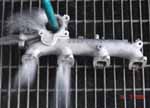 |
 |
| Nissan 4.2 Front
Entry |
Nissan 4.2 Side Entry |
Toyota Diesel |
oe
HiLux - a shocker '09 |
Big Horsepower !! |
This
part is
definitely
for a small (even tiny) minority
of '4x4ers'
This line was written in 2008. With the number of 4x4's now
being boosted
more than 6 psi. over factory, forget the word 'tiny' & just
leave it at minority.
BUT,
everybody should have a look
at the bottom
section !
|
If your
vehicle runs near the manufacturers standard boost
&
you can fit the intercooler you want properly, then
a plennum will be a waste of most of it's cost. If
you are upping the boost levels by approx. 30% or
more (some of us are very greedy!), then I would
read on & give it some thought.
Even though we were modifying Diesel manifolds 6
years ago, I would not have been game to put this
page on our site. I've always said that a diesel
engine is the same as a petrol engine, "modify it
properly & you will increase Torque & Horsepower &
decrease fuel consumption", in fact, it was easier,
as the diesels were mostly still based on the truck
design that was used to deliver material to Noah for
his ark (maybe not quite that early), & so not
suited to our power delivery needs of a people
mover.
Now, with a few LeMans wins & being hobbled too slow
them down, & the power & revs from the modern auto
diesel ( & I must say, Europe has caught the
Japanese napping) is changing everyone's thoughts &
perception of a diesel engine. Allot of these giant
gains have come from 'the good ol hot rod boys'
principles from the '50s - more air, more
compression, more fuel, more revs, less weight -
hang on tight ! The only one that's missing is more
spark ! They are all just a pump.
A diesel plennum has one big difference to a petrol
version that we are used to dealing with, It needs a
smaller internal volume. Minimum turbulence &
eddying (important), the correct volume of air
for the next stroke, as even distribution to each
port as possible. Now, this last one is not as
important as on a petrol engine. A diesel has the
ability too run noticeably leaner than a petrol
without damage ! BUT there is a limit, & it's
expensive ! With a highly tuned petrol engine, a
cylinder that is not receiving the same amount of
air, will loose ring tension, melt the piston, eat
the head gasket, burn the exhaust valve, usually in
that order. Because a diesel engine is designed for
a high compression, it is so much more over
engineered & robust & doesn't have ignition to fire
the fuel mixture regardless, they are much more
tolerant to uneven port flow. BUT, all the
components in that cylinder will wear out faster
! We are talking valve guides & springs, valves
& valve seats, headgasket around that cylinder,
rings- especially top compression, & the top of the
cylinder wall.
No scare mongering for a sale here. As I said at the
start, up too approx. 30% boost increase, you don't
have to think about the above. Depending on the
engine design & construction, the more you lean on
it from this, the closer you need too look at the
intake. |

Heath
Lawsons 100+ psi Compound Turbo Duramax V8
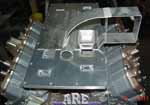 |
 |
 |
 |
 |
 |
| Mock up to see
how everything will fit |
Each venturie is
hand form -ed from 5 pieces
of alloy |
This is the bell
shape, not perfect, but lows real
well for the space we had. |
The substantial
bridge required to stop 120psi
blowing it up like a football ! |
Grooved to give a
very strong weld onto the plennum
walls. |
Tacked in place
to check alignment. Note neat fit in
curves for little distortion |
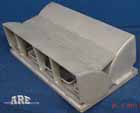 |
 |
 |
 |
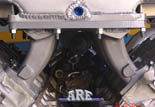 |
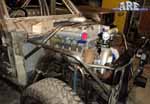 |
| Finished ready
for the water/air intercoolers. |
Strengthening
bridges in place |
Plated to
reinforce centre of rolled long
radius sheet. |
There is a
reason for spacing of bridges ? |
The two
substantial plates, once again it's
all for strength |
Trial fit up in
truck. |
|
|
Steve Mains 40+ psi Compound Turbo TD42 Street
Setup
|
EGR Systems
&
their consequences.

Currently A.R.E.
is spending considerable R&D time on developing
our own range of 4 x 4 cooling parts.
Check back for updates.

|